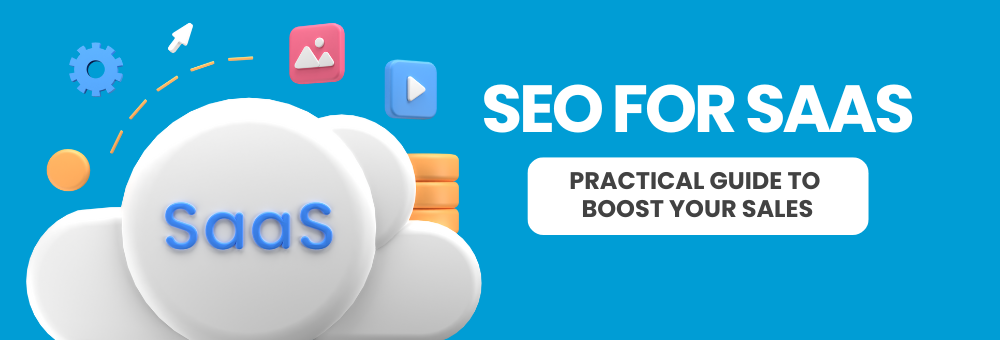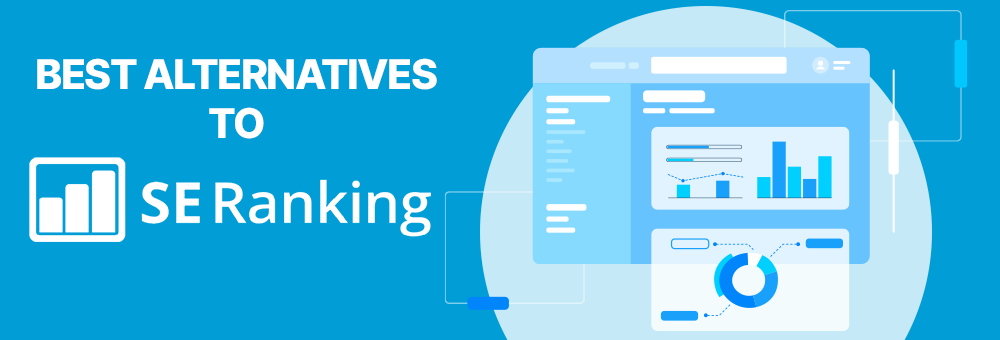If you’ve ever been part of a software project, you know that developing a web application is an expensive process filled with obstacles. That’s why many people think that once the product is finished, the hard work is over.
In reality, it’s only the beginning.
The toughest part starts now: getting someone to actually pay for your product.
In this article, I want to talk to you about SEO for SaaS — one of the most profitable strategies I know to get your project noticed and reach your potential customers naturally, without resorting to invasive promotions that might turn them away.
With SEO for SaaS, you’re not the one knocking on your future users’ doors. They’ll come to you looking for help, and you’ll show them you have exactly what they need to solve their problem.
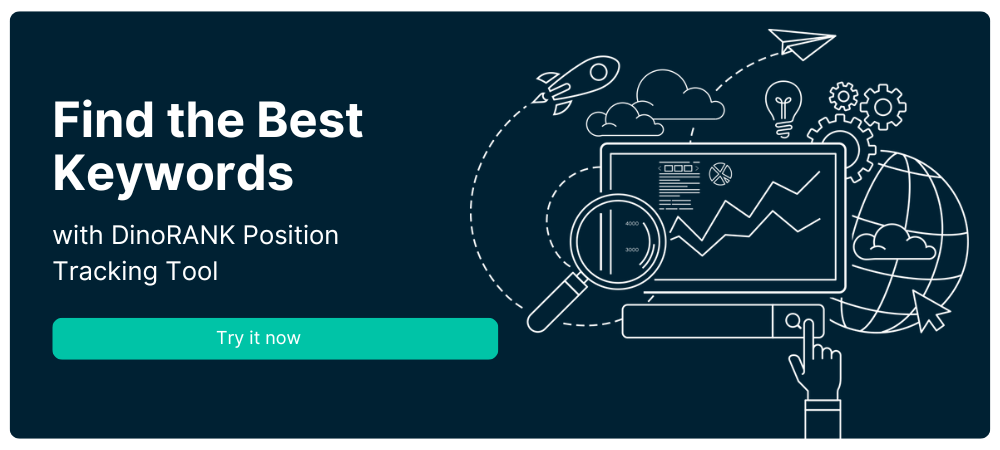
Want to know how to do it? Then don’t miss what’s coming next.
What is a SaaS?
A SaaS is an online business model that offers a software application that runs on the internet, usually through a subscription or recurring payment model.
The term SaaS comes from the English “Software as a Service,” and it has the advantage of eliminating the need for prior installations, powerful hardware infrastructure, or costly maintenance.
A good internet connection and a web browser are all a user needs to work with the software, since it runs directly in the cloud.
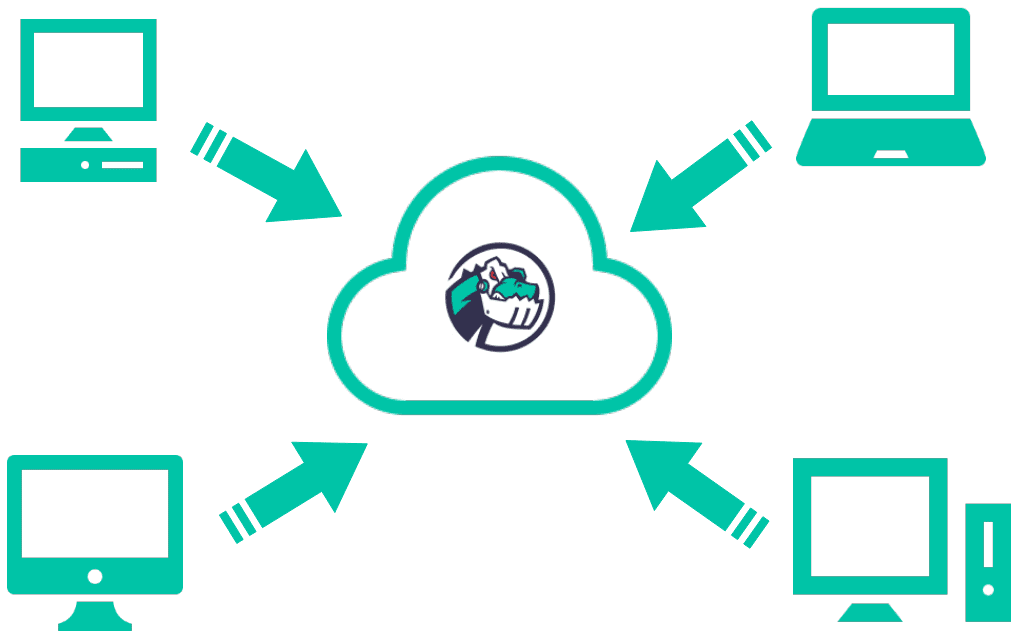
Examples of SaaS companies we all know
You might not realize it, but you use more SaaS platforms in your daily life than you think.
- Do you use Google apps? Gmail, Google Calendar, Google Docs…
- Do you store your files on Dropbox or Google Drive?
- Have you ever made video calls with Zoom or Skype?
- Do you use WhatsApp or Telegram to message friends or family?
For an SEO professional, many of their work tools are SaaS. This is the case with Ahrefs, Semrush, Google Search Console, or DinoRANK — all of them are SaaS.
Today, more and more companies are choosing to build a SaaS and base their business model and growth on it.
This is where “SEO for SaaS” plays a key role in a startup or company’s marketing strategy, as it allows them to show up with the solution right in front of the people who have the problem or need that the SaaS is solving.
What’s the importance of SEO for a SaaS business?
If you run a SaaS business, you should see SEO as a core part of your online marketing strategy.
Paid advertising, when done right, is an efficient way to get your product noticed and generate sales. However, it comes with a fairly high cost that must be kept under control.
Social media is another powerful channel to build brand awareness, but it requires consistency and, in most cases, the audience you can reach is limited. It’s also easy to reach a saturation point where your audience becomes disengaged.
The difference is that once you’ve done the work to rank, your results can last over time and continue generating sales with very little ongoing effort. This is why the long-term return is often better.
Plus, SEO responds to genuine interest.
Ads or social media posts are inherently a bit intrusive — the user doesn’t necessarily care about what you’re showing them at that moment.
However, when someone searches on Google, it’s because they have a problem — and you’re going to provide the solution.
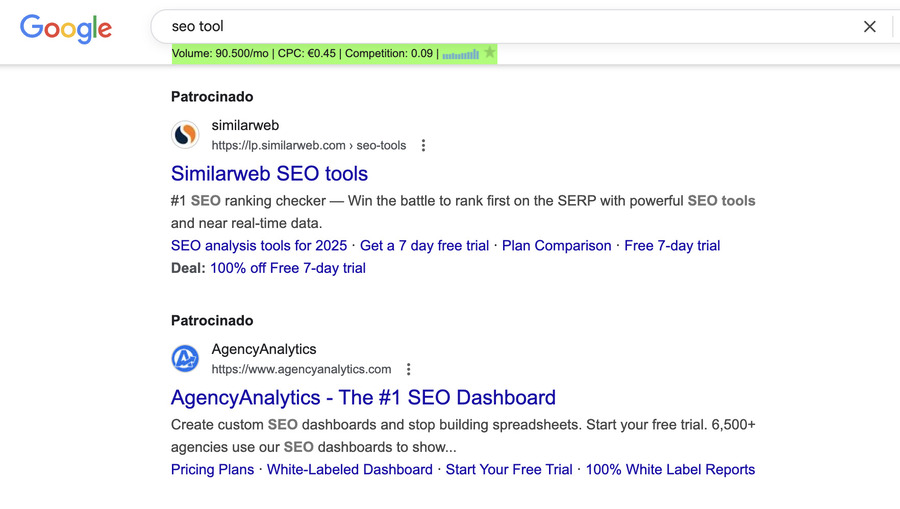
If you manage to rank in the top positions for strategic searches, you’ll attract highly qualified users to your site.
Many of them will end up subscribing to your service because it solves their specific need.
What’s one of the core concepts of an SEO strategy for SaaS companies?
Let’s go back to the phrase that closed the previous section:
“Users will end up subscribing to your service because it solves their need.”
When you do SEO for SaaS, your goal isn’t to get just anyone to visit your website — it’s to attract users who have a problem you can actually solve.
If you create useful, valuable content for your target audience, you’ll build a high level of trust in your brand, making them more likely to return to your site whenever they face similar challenges or needs.
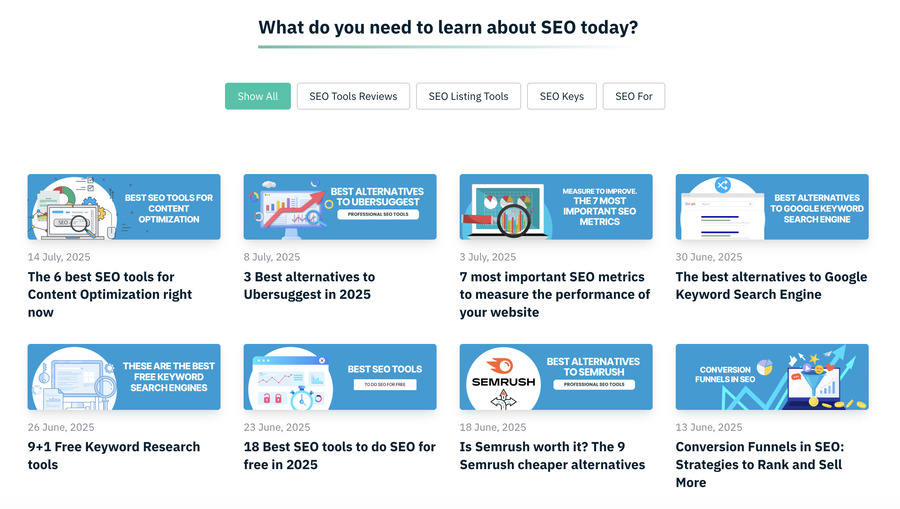
The beauty of SEO is that it always addresses the user’s main concern while introducing them to your tool — a practical software solution that solves a need, whether practical or theoretical, offering a faster, more automated, and more cost-effective answer to their problem.
This is how you spark interest in your SaaS, earn user trust, and with every new interaction, increase the likelihood of converting them into paying customers.
You’ll turn them into loyal — and likely recurring — clients who trust your software because you’ve proven its usefulness and delivered value through your SEO content.
Over time, if your SaaS continues to meet their expectations and needs month after month, it’s easy for those customers to become evangelists for your product.
How to build an SEO strategy for SaaS step by step? (real case)
Next, I want to walk you through the most important points when implementing an SEO strategy for SaaS. To do it, I’ll use our experience doing SEO for DinoRANK as a real example.
Although we could use many other tools to do SEO, at DinoRANK, an SEO SaaS, we use our own tool to run SEO on the site.
In this guide, I’ll show you how we work on SEO so you can replicate the process in your own SaaS project.
Ready to come along?
1. Identify your goals and define KPIs
When you’re about to launch an SEO strategy, it’s essential to define the goals you want to achieve.
Goals should be as concise and realistic as possible. Otherwise, you risk never hitting them or, even worse, not knowing for sure whether you’ve actually reached them.
“Increase sales” wouldn’t be a valid goal. “Increase sales by 15% over the next two months” would be.
To know whether our actions are paying off, we’ll use KPIs.
A KPI (key performance indicator) is a specific metric that gives us objective information about the results of a set of actions.
The number of sales, the volume of organic visits to our website, pages viewed per user, bounce rate, or the number of ranked keywords are all measures that can signal how our SaaS SEO strategy is performing.

2. Know about your ideal customer
If you want your SaaS —or any product or service you create— to succeed, you need to clearly identify exactly who you should be targeting.
This means defining your ideal customer, a concept in marketing known as the buyer persona.
You should know every detail about this ideal customer: their knowledge level, age, motivations, goals, and most importantly, their pain points (what problems or concerns they have).
Remember, your SaaS is a solution to their problems, which is why you need to understand them perfectly.
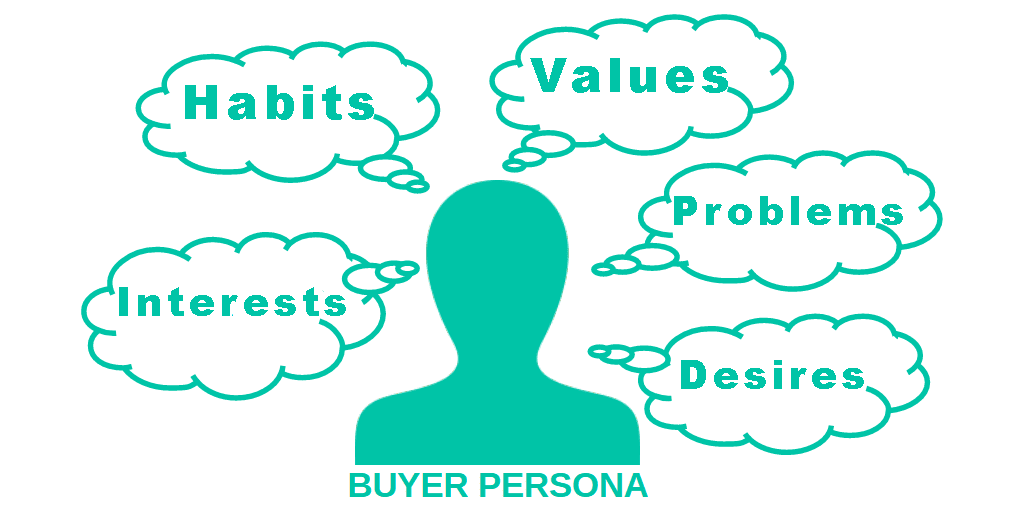
You’ll also need to define the customer journey. This involves identifying the stages a user goes through from the moment they feel a need to the moment they satisfy it.
This journey will vary depending on the situation, but it usually includes the following stages:
- Awareness – The potential customer has a problem and discovers the existence of a brand that can solve it.
- Evaluation – The customer researches the brand’s services and compares them to other options on the market.
- Purchase – The customer decides the brand’s solution best fits their needs and makes the purchase.
- Loyalty – The customer has used the product or service, liked it, and will continue using it. They may even buy other products or services from the same brand.
Knowing your ideal customer, their problems, and their decision-making or buying process is crucial when designing the elements of an SEO strategy for your SaaS.
3. Analyze what your competitors are doing
You should never lose sight of what your competitors are up to. After all, we all want the same thing: to improve the sales of our SaaS.
And we put all our efforts into achieving it.
Some strategies work better than others, and knowing them in advance can save us a lot of time and money.
If you know which other projects you’re competing against and analyze what they’ve done, you can find valuable ideas to apply for your own benefit.
With DinoRANK, we can identify the keywords that are bringing the most traffic to our competitors and integrate them into our content strategy.
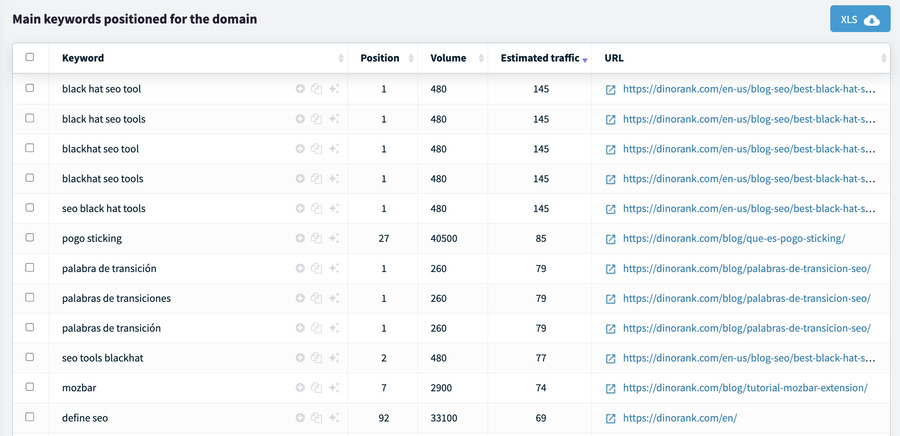
If we want to get straight to the point, we also have a feature called Content Gap that directly shows us the content other websites are ranking for but we aren’t yet.

And we can also find out which sites are linking to them, so we can replicate their link building strategy.
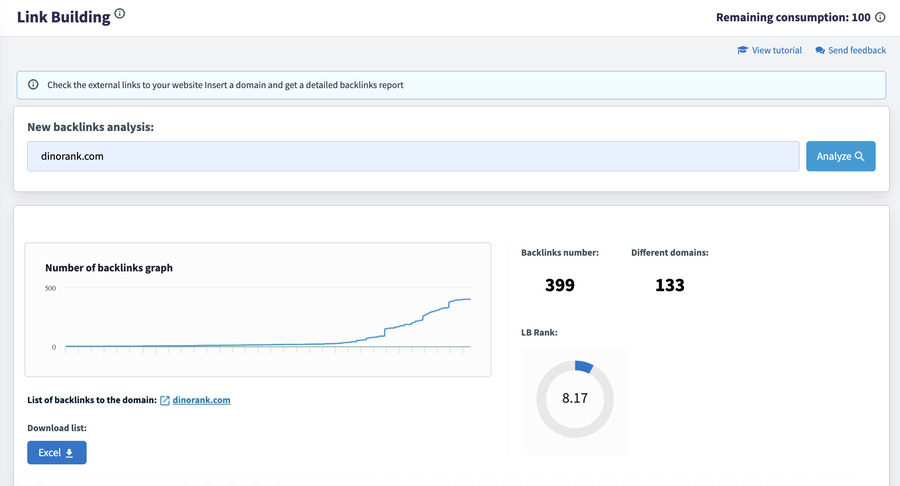
In short, competitor analysis gives us highly valuable information for planning our SaaS SEO strategy.
4. Do in-depth keyword research
We’ve reached one of the most important tasks in SEO: keyword research.
Identifying the strategic keywords you want to rank for is essential if you want to get results.
But how do you identify those keywords?
Well, if you’ve completed the previous steps, you’re already ahead of the game.
Understanding the pain points of your potential customers gives you a solid list of keywords to start with.
Now, simply run them through a keyword research tool like DinoRANK to uncover other related keywords.
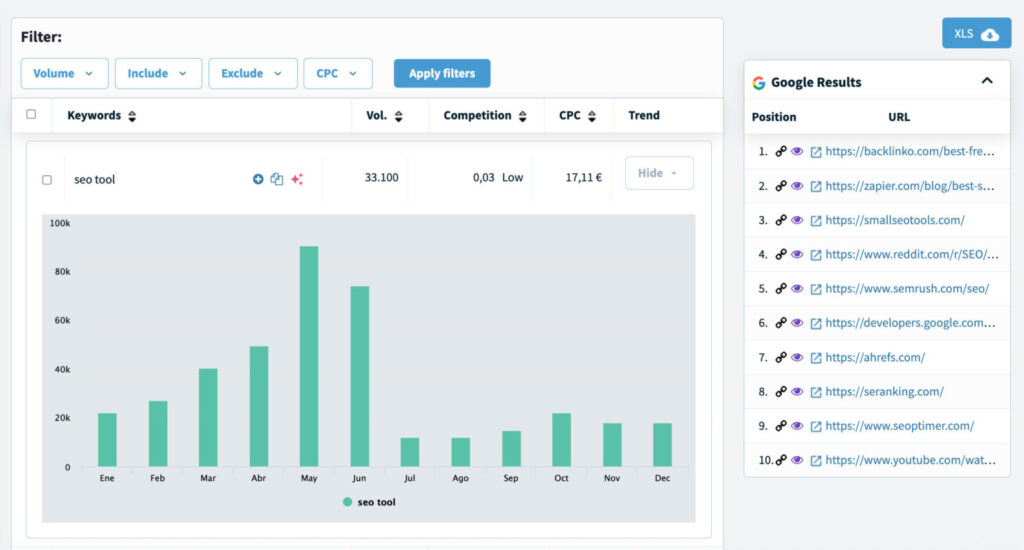
During this analysis, pay close attention to keywords made up of several terms with low search volume. These are long-tail keywords, which are easier to rank for and are essential for giving your website an initial boost.
On the other hand, your competitor analysis will also have helped you uncover a solid set of keywords to add to your SEO strategy.
Another group of keywords you can include during your keyword research are competitor brand keywords.
These types of keywords are particularly interesting because they allow you to appear for search terms related to competing brands and “steal” their traffic and sales.
- Here’s an example:
As you can see, when a user searches for a competitor on Google, our website appears among the search results. This drives qualified clicks our way, which we can quickly work to convert through our content.
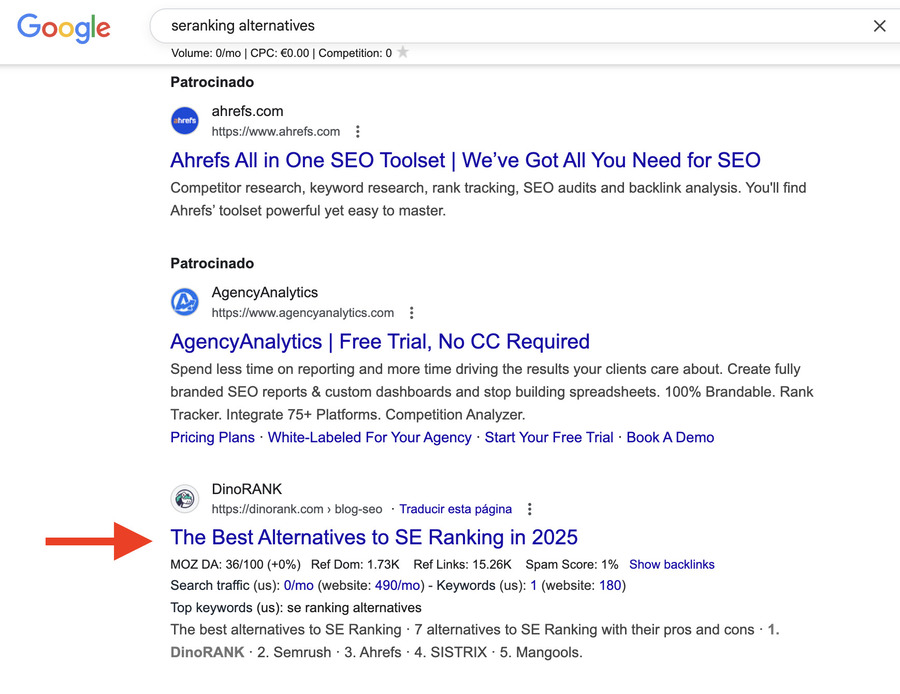
5. Organize your keywords by search intent and align them with your business
Now that you have your list of keywords, you need to organize them based on the user’s search intent.
To make this classification, it’s very helpful to have a deep understanding of your ideal customer’s journey, as it will allow you to determine whether a keyword is closer or further from the sales stage.
The concept of a sales funnel is common in marketing and represents exactly this idea. At the wide top of the funnel are the more informational searches, while at the bottom are the searches from people with clear buying intent.
Identifying the intent behind each keyword is essential if we want our content to have any chance of ranking in search engines.
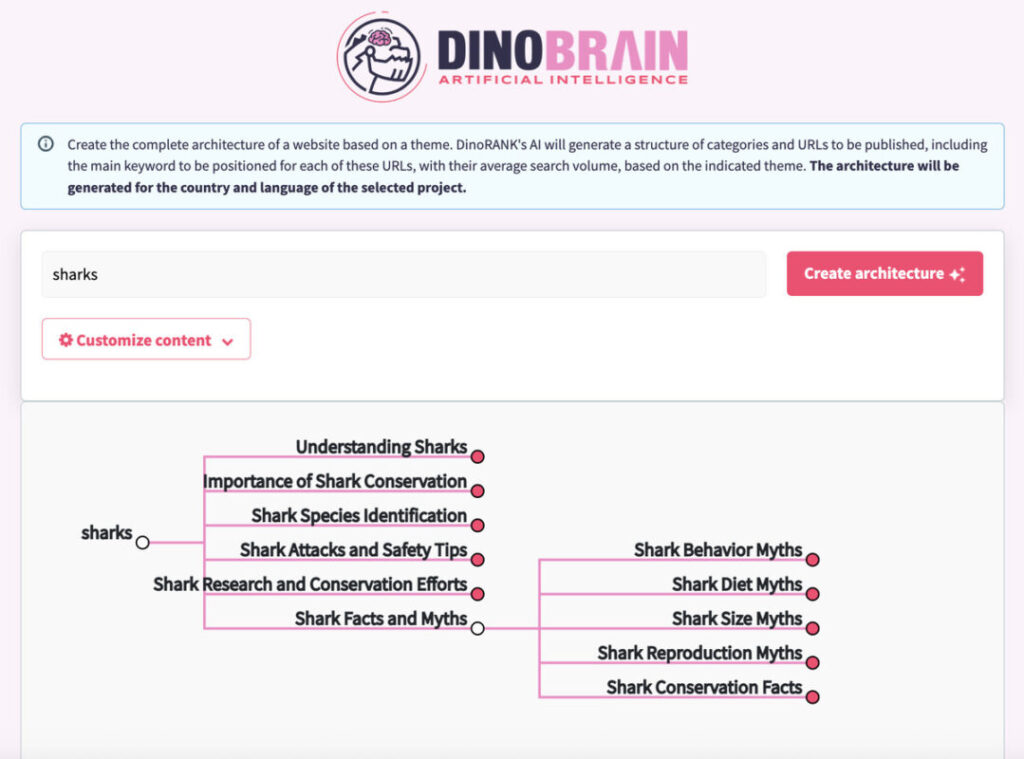
6. Create high-quality content
When creating content for our website, we should always aim for quality and provide a definitive solution to the problem we’re addressing.
So, does that mean we can’t create content with artificial intelligence?
That’s not what I mean. AI can be very useful for generating certain types of text, but it’s true that for others it may not be the best choice.
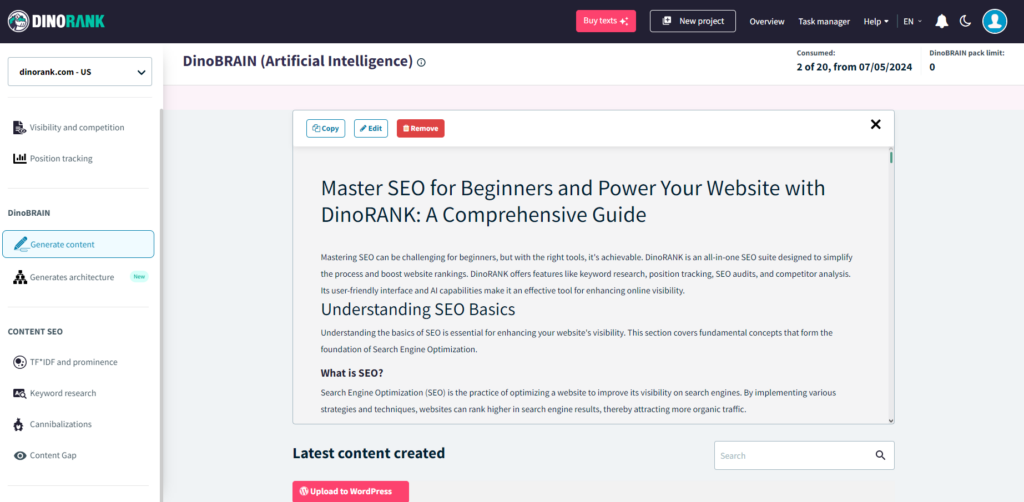
Specifically, if we need to produce an informational piece aimed at the top of the sales funnel, AI can deliver a solid result.
But when creating content that drives conversions or addresses a customer’s pain points in a more personal way, it’s essential to go beyond what AI can provide ensuring the content resonates on a human level and maintains a genuine, authentic connection with your audience.
One way to approach this is Humanize AI which refines machine-generated text so it feels more natural, authentic, and aligned with your brand voice. By humanizing AI SaaS teams can balance efficiency with genuine connection, ensuring that content attracts readers while still building trust.
With DinoBRAIN, you can easily create texts that are already SEO-optimized, which means they’re likely to rank quite well.
However, for content that’s closer to the buying decision stage, I don’t recommend writing it with AI.
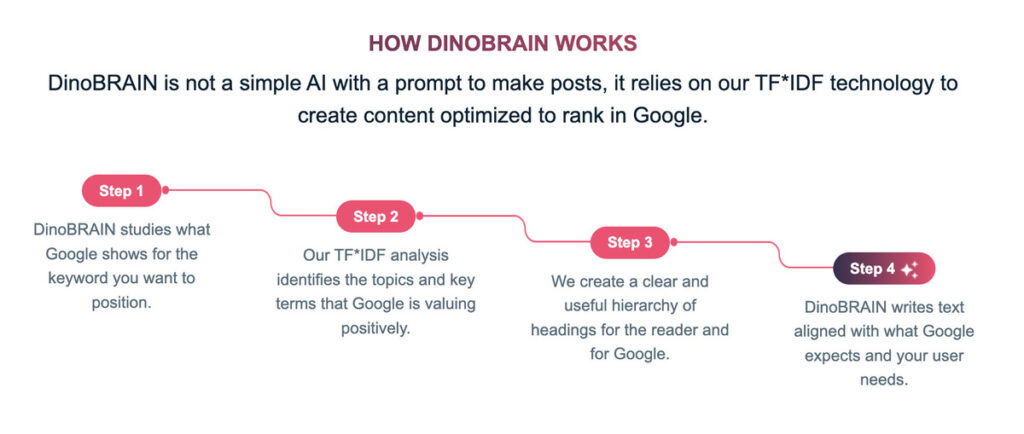
A well-crafted sales landing page copy can make the difference when it comes to convincing a potential customer.
Similarly, a comparative analysis between tools written by an expert who has actually used them as part of their work — and includes real usage examples — will be extremely valuable to the user and will greatly increase their trust in the accuracy of your site’s content.
7. Optimize your on-page SEO and internal linking
On-page SEO covers a wide range of actions that every SEO professional should know and apply to boost their page rankings.
Explaining it in detail could fill several articles. In fact, you can find plenty of information about it on the DinoRANK blog.
Since I want this guide to be practical, here’s a list of actions you should take to take care of your site’s on-page SEO.
- Run an SEO audit to fix errors.
- Optimize your content from an SEO perspective.
- Avoid duplicate content.
- Monitor your page loading speed.
- Check your site’s indexing.
- Review the internal linking between your content.
Regarding the last point, I want to emphasize the importance of proper internal linking.
When you link content to other pages, you’re not only pointing the user toward other useful information — you’re also signaling to Google which other pages on your site are important and should be crawled.
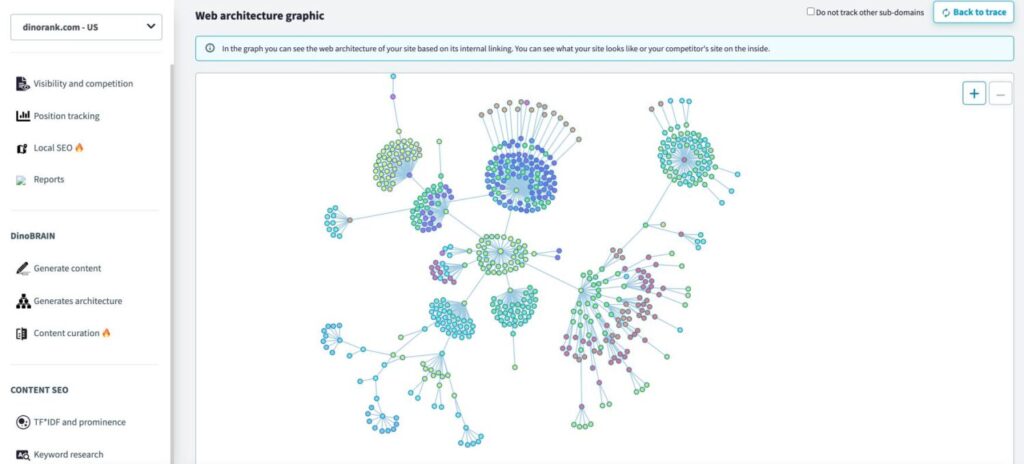
That’s why, to improve your SaaS sales, it’s a good idea to create quality informational content and link from there to your most transactional pages.
This way, you distribute authority and guide the user naturally toward making a purchase.
8. Work on your off-page SEO
Once you’ve made sure all the elements on your site are optimized, it’s time to focus on external factors.
Here’s a comprehensive guide to help you work on your site’s off-page SEO. In short, the most important actions are:
- Designing a link-building strategy.
- Publishing on social media.
- Building your brand through outreach efforts.
Regarding link building, we’ve already seen how analyzing your competitors can give you ideas for external links you might want to acquire.
But at this stage, I don’t want you to get obsessed with getting exactly the same backlinks as your competition. When planning a link-building strategy, your priority should always be to create high-quality links — thematically relevant ones that can bring you traffic.
Think of your backlinks like billboards in strategic locations, designed to capture more customers.
The same applies to social media. If we know how to leverage its potential, it’s a powerful channel to gain visibility and showcase the benefits of our solution.
9. Take care of EEAT
At the beginning of this post, we talked about trust — a factor in SEO that is closely tied to EEAT.
EEAT stands for Experience, Expertise, Authoritativeness, and Trust, and it’s something Google is paying more and more attention to, especially in certain industries.
If your website’s goal is to sell something, EEAT is almost essential.
But not just because Google says so — credibility and trust are key for anyone to be willing to buy what you offer.
For a SaaS, there are many actions you can take to strengthen EEAT.
- Provide information about every member of the team behind the project.
- Upload real-time demo videos of the SaaS in action.
- Offer clear details about specifications, pricing, and payment terms.
- Publish complete, high-quality guides on different topics related to your niche.
- Honestly compare your SaaS with other competing solutions, showing both pros and cons.
- Display genuine user reviews.
All of these actions help improve your brand image and make users see you as a serious and trustworthy project.
10. Measure and analyze your results
Once you’ve implemented all the steps of your SEO strategy for SaaS, it’s time to evaluate the results using the KPIs you defined in step one.
At this stage, Google Search Console and Google Analytics are two key tools that can give you much of the data you need.
But they’re not the only ones.
Personally, one of the things I like to keep the closest eye on is the performance of the project’s most important keywords.
For this, DinoRANK’s position tracking has become an essential part of my daily workflow.
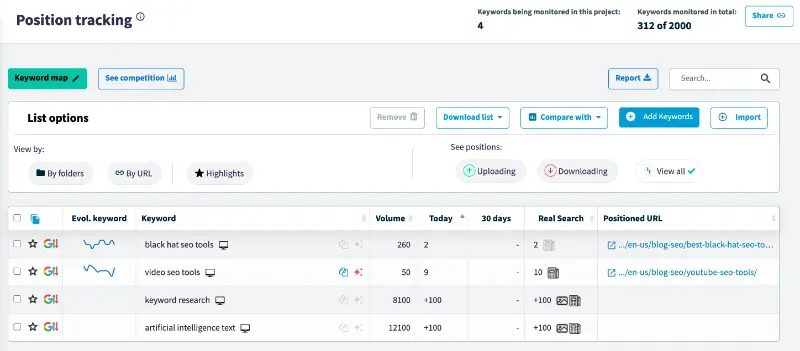
Thanks to this feature, I always have a clear and complete view of the project’s overall progress and of each keyword’s performance in particular.
This way, I can decide with great precision which areas to focus my efforts on to give the entire SEO strategy a boost.
Conclusions on SEO for SaaS
Throughout my career, I’ve seen software companies with very powerful products that had to stop selling.
The reason: they didn’t know how to capture the public’s attention.
Digital marketing is essential today if you want to make your product known and generate interest around it. But sometimes, it doesn’t get the attention and resources needed to make that happen.
SEO for SaaS is part of these online marketing strategies. When executed correctly, it can deliver significant long-term benefits.
In this article, I’ve shown you how you can grow a SaaS project using SEO through 10 very specific steps that will help you attract more customers by leveraging the visibility provided by search engines.
So, if you have a SaaS, I encourage you to start working on SEO as soon as possible — you’ll see that sooner rather than later, your sales will start to improve substantially.


